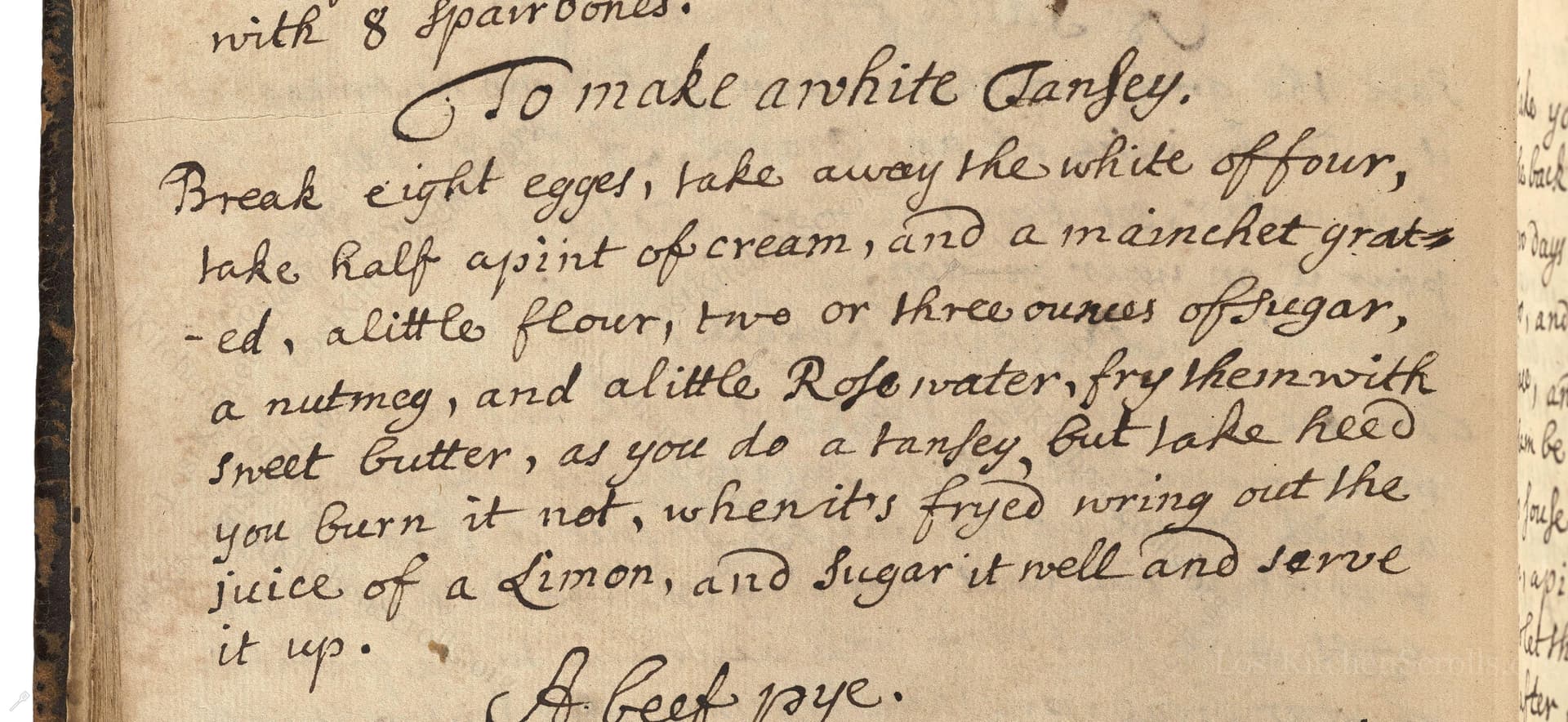To Make A White Tansy
From the treasured pages of Cookbook
Unknown Author

To Make A White Tansy
"Break eight egges, take away the white of four, take half a pint of cream, and a manchet grated, a little flour, two or three ounces of Sugar, a nutmeg, and a little Rosewater, fry them with sweet butterr, as you do a tansey, but take heed you burn it not, when its fryed wring out the juice of a limon, and sugar it well and serve it up."
Note on the Original Text
This recipe follows the typical conventions of early 18th-century English manuscript cookery: quantities are sometimes inexact and rely on the cook’s judgement and familiarity with ingredients. Spelling is unconstrained by modern form—'egges' for eggs, 'manchet' for a fine white roll, and 'tansey' instead of tansy. Directions are brief, assuming the reader knows the general method for frying such mixtures, and instructions like 'fry them...but take heed you burn it not' reflect a trust in the cook’s skill and attention.

Title
Cookbook (1706)
You can also click the book image above to peruse the original tome
Writer
Unknown
Era
1706
Publisher
Unknown
Background
Step back to the early 18th century with this charming culinary collection, brimming with period recipes that tantalize the tastebuds and offer a delicious glimpse into historic kitchens.
Kindly made available by
Folger Shakespeare Library
This recipe for 'White Tansy' comes from an English household manuscript around 1706, a time when tansy—usually a green, herby pudding flavored with bitter tansy leaves—appeared in many springtime feasts, symbolizing renewal and fresh beginnings. By the early 18th century, some cooks adapted the dish into a delicate, lemony-sweet omelet or pudding, omitting the bitter herbs. Cream, eggs, breadcrumbs, and aromatics like nutmeg and rosewater created a luxurious yet familiar treat, often served on feast days such as Easter. It’s also a fine example of the evolving tastes of the age—sugar, rosewater, and spices were increasingly accessible, while wealthy kitchens experimented with lighter, more refined desserts reflecting the culinary creativity of early-modern Britain.

In the early 1700s, a cook would have used a deep, heavy frying pan or skillet placed over an open fire or set atop a bed of embers. Mixing was done by hand in large earthenware or wooden bowls, with ingredients combined using a spoon or whisk, likely made from wood or metal. Grating bread would involve a hand grater. The rich tansy was fried in butter, watched carefully by the cook to prevent scorching, and served hot from pan to plate, probably using pewter or pottery serving dishes.
Prep Time
10 mins
Cook Time
15 mins
Servings
4
We've done our best to adapt this historical recipe for modern kitchens, but some details may still need refinement. We warmly welcome feedback from fellow cooks and culinary historians — your insights support the entire community!
Ingredients
- 8 large eggs (use only 4 of the whites)
- 1 cup heavy cream
- 2 oz fresh white breadcrumbs or finely grated white roll (manchet)
- 1 tablespoon plain flour (about 1/3 oz)
- 1-1¼ oz granulated sugar (2-3 tablespoons), plus more for sprinkling
- 1/2 teaspoon grated nutmeg
- 1 teaspoon rosewater (about 1/6 fl oz, or to taste)
- 1 lemon (for juice)
- 1 oz unsalted butter (for frying)
Instructions
- Begin by cracking 8 large eggs, but discard the whites of 4, leaving you with 8 yolks and 4 whites.
- Add 1 cup (about half a pint) of heavy cream to a mixing bowl.
- Grate a small white bread roll (about 2 oz), or use about 2 oz of fresh breadcrumbs, and add them to the eggs and cream.
- Sift in 1 tablespoon (about 1/3 oz) of plain flour.
- Stir in 2-3 tablespoons (1-1¼ oz) of granulated sugar, a generous sprinkle of grated nutmeg (about 1/2 teaspoon), and 1 teaspoon (about 1/6 fl oz) of rosewater.
- Mix thoroughly until smooth.
- Heat a large nonstick frying pan over medium-low heat and melt 2 tablespoons (1 oz) of unsalted butter.
- Pour in the mixture and fry gently, as if making a thick omelet, being careful not to let it burn or brown significantly.
- When the mixture is set and lightly golden, squeeze the juice of one lemon over the top and dust liberally with sugar before serving.
- Serve immediately, warm and aromatic.
Estimated Calories
350 per serving
Cooking Estimates
It usually takes about 10 minutes to prepare the ingredients and another 10-15 minutes to cook the dish in the pan. This recipe makes about 4 servings. Each serving has around 350 calories.
As noted above, we have made our best effort to translate and adapt this historical recipe for modern kitchens, taking into account ingredients nowadays, cooking techniques, measurements, and so on. However, historical recipes often contain assumptions that require interpretation.
We'd love for anyone to help improve these adaptations. Community contributions are highly welcome. If you have suggestions, corrections, or cooking tips based on your experience with this recipe, please share them below.
Join the Discussion
Rate This Recipe

Den Bockfisch In Einer Fleisch Suppen Zu Kochen
This recipe hails from a German manuscript cookbook compiled in 1696, a time whe...

Die Grieß Nudlen Zumachen
This recipe comes from a rather mysterious manuscript cookbook, penned anonymous...

Ein Boudain
This recipe comes from an anonymous German-language manuscript cookbook from 169...

Ein Gesaltzen Citroni
This recipe, dating from 1696, comes from an extensive anonymous German cookbook...
Browse our complete collection of time-honored recipes



